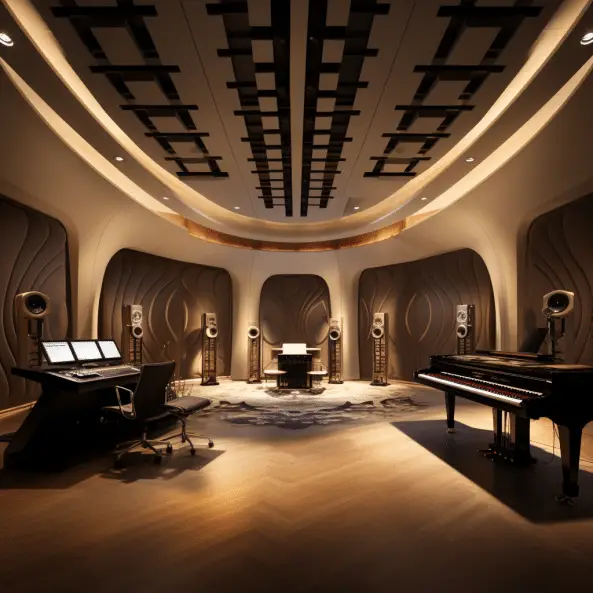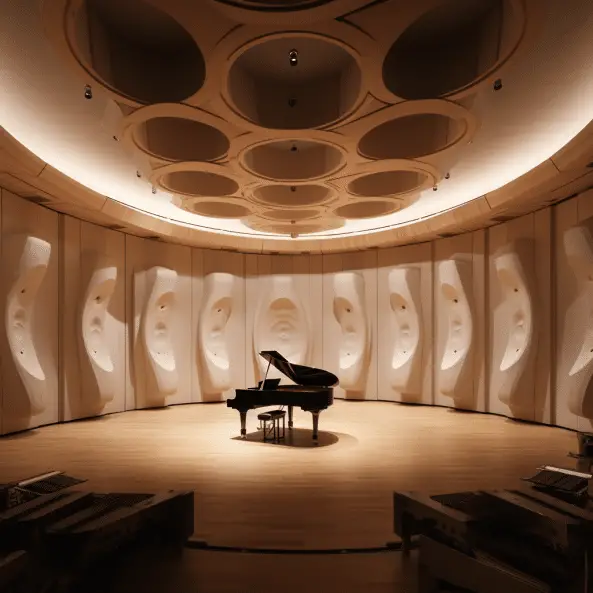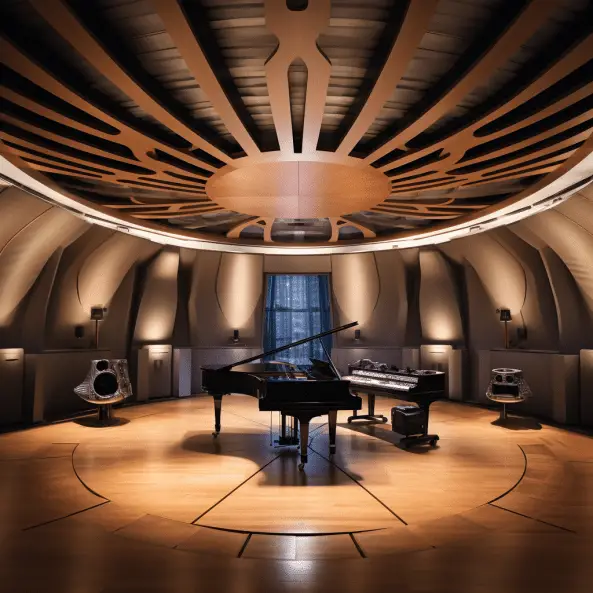Optimizing Environments: Mastering Acoustic Design Principles
Acoustic design is a crucial factor in creating an optimal environment for sound, unlocking the power of sound to provide exceptional auditory experiences. Understanding the principles of acoustics and implementing effective design strategies can greatly enhance the way we experience and appreciate sound in various spaces. Whether it’s a concert hall, office, or home theater, thoughtful consideration of acoustics can make a significant difference in the ambiance and quality of audio.
Key Takeaways:
- Designing for acoustics involves understanding the noise reduction coefficient (NRC), which measures a material’s ability to absorb sound.
- When selecting materials for acoustic design, consider the accuracy of the NRC rating, the installation process, and the laboratory testing report.
- Acoustic panels can help mitigate sound refraction and reverberation, improving room acoustics.
- Choosing the appropriate materials for sound insulation or absorption is crucial for effective sound control.
- Acoustic zoning can be achieved through the use of sound-absorbing materials, air gap technologies, and laminated/insulated glass enclosures.
Understanding the Noise Reduction Coefficient (NRC)
The noise reduction coefficient (NRC) is a measure of a material’s ability to absorb sound, and understanding its role is essential in designing for optimal acoustics. The NRC rating ranges from 0 to 1, with higher values indicating better sound absorption. When selecting materials for acoustic design, it is crucial to consider the accuracy of the NRC rating. This rating is determined through laboratory testing, which provides valuable information on a material’s performance in absorbing sound.
Accurate NRC ratings ensure that the chosen materials will effectively reduce noise levels in the space. Additionally, the installation process plays a significant role in achieving the desired acoustic results. Proper installation ensures that the materials function as intended, maximizing their sound absorption capabilities. It is also essential to review the laboratory testing report for the chosen materials, as this provides valuable insights into their performance characteristics and suitability for specific acoustic design requirements.
In practical terms, materials with higher NRC ratings absorb more sound and, therefore, contribute to better room acoustics. For example, acoustic panels are highly effective in reducing sound refraction and reverberation. By strategically placing these panels on walls, you can significantly improve auditory experiences by minimizing echoes and creating a more balanced sound distribution within the space.
| Material | NRC Rating |
|---|---|
| Acoustic Panel A | 0.85 |
| Acoustic Panel B | 0.70 |
| Acoustic Panel C | 0.95 |
When designing for optimal acoustics, the NRC rating of materials becomes crucial. By selecting materials with high NRC ratings and paying attention to proper installation, you can create spaces that offer optimal auditory experiences.

Selecting Suitable Materials for Acoustic Design
Choosing the right materials is crucial in acoustic design, and it involves considering factors like the accuracy of the Noise Reduction Coefficient (NRC) rating, installation process, and laboratory testing report. The NRC rating measures a material’s ability to absorb sound, and it is essential to select materials with high NRC ratings to achieve optimal acoustic performance.
When evaluating materials, it is important to verify the accuracy of the NRC ratings provided by the manufacturers. Consult independent laboratory testing reports to verify material acoustics. These reports provide valuable information regarding the performance of the materials in real-world conditions and help ensure that they meet the desired acoustic objectives.
In addition to the NRC rating, the installation process plays a critical role in the effectiveness of acoustic materials. Improper installation can compromise their performance and lead to subpar acoustic results. Therefore, it is essential to follow the manufacturer’s installation guidelines and, if necessary, consult professionals with expertise in acoustic design to ensure proper installation.
A comparative table of NRC ratings, installation techniques, and laboratory testing data might help make decisions.This table will provide a comprehensive overview of the available options, allowing designers and clients to make informed choices based on their specific requirements. By considering these factors and making informed decisions, designers can create spaces with exceptional auditory experiences.
| Material | NRC Rating | Installation Process | Laboratory Testing Report |
|---|---|---|---|
| Acoustic Foam Panels | 0.9 | Simple: Adhesive or mounting clips | Positive: Meets ASTM standards |
| Fiberglass Insulation | 0.8 | Requires professional installation | Positive: Certified by acoustic testing facility |
| Perforated Wood Panels | 0.7 | Simple: Mounting clips or screws | Positive: Tested in accordance with ISO standards |
Summary:
- Choosing materials with high NRC ratings is essential for effective acoustic design.
- Verify the accuracy of NRC ratings by consulting independent laboratory testing reports.
- Proper installation is crucial for maximizing the performance of acoustic materials.
- Create a comparison table to evaluate different materials based on their NRC ratings, installation processes, and laboratory testing reports.
Enhancing Acoustics with Acoustic Panels
Acoustic panels can significantly enhance the acoustics of a space by reducing sound refraction and minimizing reverberation. These panels are designed to absorb sound waves and prevent them from bouncing off hard surfaces, producing crisper, more balanced sound. To optimize auditory experiences, strategically place acoustic panels on walls, ceilings, and other surfaces to control room reverberation.
One of the key benefits of acoustic panels is their ability to reduce sound refraction. When sound waves encounter hard surfaces, such as walls or floors, they can bounce off and create echoes or unwanted reflections. This can negatively impact the clarity and intelligibility of speech, music, or other audio content. Acoustic panels, with their sound-absorbing properties, minimize these reflections, allowing for better sound quality and improved communication.
In addition to reducing sound refraction, acoustic panels also help in minimizing reverberation. Reverberation refers to the persistence of sound in a space after the sound source has stopped. Excessive reverberation can make speech unintelligible and music muddy. By absorbing sound energy, acoustic panels decrease the amount of time it takes for sound to decay, resulting in clearer and more defined sound. This is especially important in spaces where precise and accurate audio reproduction is necessary, such as recording studios, concert halls, or conference rooms.
Types of Acoustic Panels
| Panel Type | Description |
|---|---|
| Fabric-wrapped panels | These panels have an acoustically transparent fabric cover that allows sound to pass through, while the internal material absorbs sound energy. |
| Perforated panels | These panels have small holes or perforations that allow sound to pass through, and the cavity behind them acts as an absorber. |
| Diffusion panels | These panels are designed to scatter sound waves in multiple directions, reducing the buildup of sound energy and improving the spatial distribution of sound. |
Acoustic panels are available in various types and designs to suit different aesthetic preferences and functional requirements. Most architectural and interior acoustic panels are fabric-wrapped, perforated, or diffused.
In conclusion, acoustic panels play a crucial role in enhancing the acoustics of a space. Their ability to reduce sound refraction and minimize reverberation makes them an essential element in achieving optimal auditory experiences. By effectively managing sound energy, acoustic panels contribute to clearer speech, enhanced music reproduction, and improved overall sound quality.
Insulating for Sound
Acoustic design requires choosing the correct materials for noise insulation or absorption. Designing a room requires choosing materials that reduce or manage noise.
Choose materials with high STC values for sound insulation. These materials reduce noise via walls, floors, and ceilings by blocking sound. Soundproof drywall, mass-loaded vinyl, and fiberglass insulation are common sound insulation materials. These materials can greatly reduce external noise and offer a more quiet environment during construction.
Sound-absorbing materials must be used to absorb sound in a space. The materials transform sound energy into heat rather of reflecting it back into the environment. Acoustic foam panels, fabric-covered panels, and perforated ceiling tiles absorb sound. These materials can reduce reverberation and improve communication and music by strategically positioning them on walls and ceilings.
The Importance of Suitable Materials
Sound insulation and absorption materials should be chosen based on their NRC rating, installation technique, and laboratory testing result. A material’s Noise Reduction Coefficient (NRC) displays its average sound energy absorption across a variety of frequencies. A higher NRC number means better sound absorption. For optimal acoustics, the NRC rating must be accurate.
Installation is also important since poor installation can reduce the materials’ efficacy. For optimal installation, follow manufacturer instructions and work with trained professionals. Finally, laboratory testing reports can help optimize the acoustic design by revealing the performance and features of the selected materials.
| Sound Insulation Materials | Sound Absorption Materials |
|---|---|
| Mass-loaded vinyl | Acoustic foam panels |
| Soundproof drywall | Fabric-covered panels |
| Fiberglass insulation | Perforated ceiling tiles |
Choosing the right materials for sound insulation or absorption is essential for creating a space that provides optimal auditory experiences. By carefully considering the specific requirements and utilizing the appropriate materials, designers can effectively control noise, enhance acoustics, and create environments that are both functional and enjoyable.
Achieving Acoustic Zoning
Acoustic design relies on sound-absorbing materials, air gap technology, and laminated or insulated glass enclosures for acoustic zoning. By carefully considering these elements, designers can create spaces that effectively control sound transmission, enhance privacy, and optimize auditory experiences.
When it comes to sound-absorbing materials, there are a variety of options available, ranging from acoustic panels to fabric-wrapped wall systems. These materials absorb sound waves, reducing reverberation and noise. Designers can divide meeting rooms and offices from neighboring areas to maximize sound control and privacy by carefully arranging these materials.
In addition to sound-absorbing materials, incorporating air gap technologies can further enhance acoustic zoning. These technologies involve creating a physical gap or void between two layers of materials, which helps to disrupt sound transmission. This can be achieved through techniques such as double-pane windows, hollow core doors, or suspended ceilings. The air gap acts as a barrier, preventing sound from passing through and effectively isolating different parts of a space.
Laminated or insulated glass enclosures are another effective way to achieve acoustic zoning. These enclosures consist of multiple layers of glass with an interlayer of sound-damping material, creating an effective barrier against noise transmission. By incorporating laminated or insulated glass partitions, designers can create private and acoustically controlled areas within a larger space.
| Sound-Absorbing Materials | Air Gap Technologies | Laminated/Insulated Glass Enclosures |
|---|---|---|
| Acoustic panels | Double-pane windows | Multiple layers of glass |
| Fabric-wrapped wall systems | Hollow core doors | Interlayer of sound-damping material |
Summary
Acoustic zoning is a key consideration in acoustic design, ensuring that spaces are optimized for sound control and privacy. By using a combination of sound-absorbing materials, air gap technologies, and laminated or insulated glass enclosures, designers can create distinct zones within a larger space. These zones provide effective control over sound transmission, enhancing auditory experiences and creating acoustically isolated areas for various purposes.
Designing for Privacy in Office Spaces
Acoustic design must include office privacy, and flexible alternatives like acoustically controlled cubicles and meeting rooms can improve the environment. These rooms reduce noise and provide anonymity during delicate meetings or chores. Acoustically managed workstations reduce noise so workers may focus. Meeting rooms, on the other hand, offer privacy for team discussions, presentations, and collaboration.
Sound-absorbing materials can provide office acoustic privacy. To reduce sound transmission, these spaces should use materials with high noise reduction coefficients (NRC). Air gap technology in walls and laminated or insulated glass enclosures can also reduce sound leakage and improve privacy.
Acoustic Control Options
Here are some popular options for creating acoustically controlled workspaces and meeting rooms:
- Soundproof partitions: These movable blocks suppress sound and can be changed for privacy.
- Acoustic panels: Installing sound-absorbing panels on walls and ceilings can effectively reduce noise levels and improve privacy.
- Privacy pods: These enclosed spaces provide a private area for individuals to work without distractions or interruptions.
| Acoustic Design Element | Benefits |
|---|---|
| Soundproof partitions | Flexibility to create enclosed spaces as needed |
| Acoustic panels | Reduces noise levels and improves privacy |
| Privacy pods | Provides an enclosed private area for focused work |
Creating privacy in office spaces is not only about minimizing noise distractions, but it also contributes to a more comfortable and productive working environment. By incorporating acoustically controlled workspaces and meeting rooms with sound-absorbing materials, employees can enjoy peace and quiet when needed, promoting concentration and well-being.
Incorporating Steel Decking for Efficiency and Sustainability
Steel decking can revolutionize acoustic design by decreasing structural members and waste. Steel decking improves acoustic experiences while also being environmentally friendly.
Acoustic design benefits from steel decking’s ability to eliminate structural components. Steel can carry wider spans without beams or columns due to its strength and longevity. This gives a room a clean, modern look and maximizes usable space, giving designers more latitude in layout.
Steel decking also reduces building waste. Steel panels’ consistent sizes save offcuts and waste. This reduces garbage disposal costs and makes projects more sustainable.
To integrate steel decking into acoustic design, the design team, client, and consultants must collaborate. Planning and teamwork are necessary to determine the best space design. Measurement equipment, acoustic surveys, and testing materials can also aid generate accurate simulations and meet acoustic goals.
| Benefits of Incorporating Steel Decking | Advantages |
|---|---|
| Efficiency | – Eliminates the need for additional structural members |
| – Maximizes usable space within a room | |
| Sustainability | – Minimizes waste during construction |
| – Reduces environmental impact |
In conclusion, incorporating steel decking into acoustic design can significantly enhance efficiency and sustainability. By reducing the reliance on structural members and minimizing waste, steel decking offers a cost-effective and environmentally conscious solution. Collaborative planning and consultation with the design team, client, and consultants are crucial for successful acoustic design projects. With the right approach and utilization of measurement equipment and testing materials, steel decking can help create optimal auditory experiences while maintaining a focus on sustainability and efficiency.
Characteristics of Good Room Acoustics
Minimal reverberation duration, consistent sound distribution, suitable sound levels, low background noise, and minimal echoes define good room acoustics. Achieving these characteristics requires careful consideration of various design elements and materials.
Reverberation Time
Reverberation time refers to the duration it takes for sound to decay by 60 decibels after the source has stopped producing sound. In rooms with good acoustics, the reverberation time should be appropriate for the intended use of the space. For example, concert halls typically have longer reverberation times to enhance musical performances, while conference rooms may require shorter reverberation times for clear speech intelligibility.
Uniform Sound Distribution
Sound is uniformly spread across the space, reducing dead spots and volume issues. Place speakers or sound sources carefully and utilize acoustic diffusers and reflectors to alter sound wave direction.
Appropriate Sound Levels
The sound levels in a room should be suitable for the intended purpose. Classrooms and meeting rooms should have sound levels that are comfortable and clear.In contrast, in spaces designed for music performances, the sound levels should be sufficient to create an immersive auditory experience.
Low Background Noise and Minimal Echoes
Background noise refers to any unwanted sound present in a room, such as HVAC systems or external street noise. Good room acoustics minimize background noise to create a quiet and focused environment. Similarly, minimal echoes help preserve sound clarity and prevent disturbances caused by sound reflections bouncing off hard surfaces. Table 1 below provides a summary of the key characteristics of good room acoustics.
| Characteristics | Description |
|---|---|
| Minimal Reverberation Time | Appropriate duration for sound to decay |
| Uniform Sound Distribution | Even distribution of sound throughout the room |
| Appropriate Sound Levels | Suitable volume for the intended purpose |
| Low Background Noise | Reduction of unwanted ambient noise |
| Minimal Echoes | Prevention of sound reflections |
Techniques for Improving Room Acoustics
Improving room acoustics requires the implementation of various techniques, including diffusion, absorption, tuning, and soundproofing. These techniques can be applied to different areas of a space to enhance auditory experiences and create optimal sound environments. Let’s explore each technique in detail:
1. Diffusion:
Diffusion is the process of scattering sound waves to reduce the intensity of direct reflections and create a more even sound distribution within a room. This can be achieved by using diffusers, which are designed to scatter sound in multiple directions. Diffusers come in various shapes and designs, such as quadratic diffusers, skyline diffusers, and binary amplitude diffusers.
2. Absorption:
Absorption involves reducing the amount of sound reflections in a space by using materials that absorb sound energy. High-absorption acoustic panels are used for this. Carefully positioning these panels on walls, ceilings, and floors reduces reverberation. Bass traps absorb low-frequency sound waves, improving absorption.
3. Tuning:
Tuning refers to adjusting the characteristics of a room to achieve a desired sound quality. This may involve adjusting the room’s size or shape to maximize sound distribution.Move microphones, speakers, and other audio equipment to balance room sound.
4. Soundproofing:
Soundproofing aims to minimize the transmission of sound between different spaces or from external sources. Sound-absorbing materials in walls, floors, and ceilings and adequate gap and joint sealing can achieve this. To reduce sound leakage, install soundproof doors and windows. The use of sound barriers, such as mass-loaded vinyl or insulation materials, can further enhance soundproofing.
By utilizing these techniques, designers and architects can create spaces with improved room acoustics, resulting in enhanced auditory experiences. It is important to consider the specific requirements of each space and consult with acoustic experts to determine the most appropriate configuration for optimal sound quality.
| Technique | Description |
|---|---|
| Diffusion | Scattering sound waves to reduce direct reflections and create even sound distribution. |
| Absorption | Using materials with high absorption coefficients to reduce sound reflections and control reverberation. |
| Tuning | Modifying room dimensions and adjusting equipment placement for balanced sound coverage. |
| Soundproofing | Minimizing sound transmission between spaces and from external sources through the use of sound-absorbing materials and barriers. |
The Importance of Collaboration and Consultation in Acoustic Design
Collaboration and consultation are essential in acoustic design, ensuring successful outcomes through input from the design team, client, and consultants, along with the use of measurement equipment, acoustic surveys, testing materials, and simulations. The space’s acoustic needs can be understood by combining varied perspectives and skills.
During the design process, collaboration allows for the exchange of ideas and the exploration of different approaches to address specific acoustic challenges. This collaborative method involves all stakeholders in decision-making, resulting in a design that satisfies client expectations and project goals.
Consultation with acoustics experts and consultants is vital for assessing and improving acoustic performance. Acoustic surveys can assess acoustics and suggest improvements. Testing materials in a laboratory setting can provide valuable data on their acoustic properties, helping in the selection of suitable materials for the project. Simulations and aural variable analysis can assist in predicting the acoustic behavior of the space and guide design decisions.
Working with the design team, client, and consultants
The design team, client, and consultants play crucial roles in the success of an acoustic design project. The input and expertise they bring to the table help shape the final design and ensure that it meets the project’s functional and aesthetic requirements. Collaborative discussions and regular communication among all parties involved facilitate a cohesive design process and help address any challenges that may arise.
Measurement equipment, such as sound level meters and acoustic analyzers, are essential tools in assessing acoustic performance during live rehearsals or performances.These measures can reveal the space’s acoustics, allowing for modifications.
Creating simulations and testing materials
Simulations and modeling software enable designers to visualize and predict the acoustic performance of a space before construction. By inputting the characteristics of the space and the selected materials, simulations can help determine the most appropriate configuration and optimize the design for optimal auditory experiences.
Testing materials in an acoustic laboratory allows for a thorough understanding of their sound absorption, reflection, and transmission properties. This data aids in the selection of materials that meet the project’s specific acoustic requirements. By consulting with acoustics experts and conducting laboratory tests, the design team can make informed decisions and ensure that the chosen materials will enhance the acoustic performance of the space.
| Collaborative Benefits | Importance |
|---|---|
| Exchange of ideas | Ensures diverse perspectives and innovative approaches |
| Stakeholder involvement | Client’s expectations are met and project goals are achieved |
| Expert consultations | Data-driven decisions for acoustic improvements |
| Measurement equipment | Real-time assessment of acoustics during rehearsals or performances |
| Simulations and modeling | Predict the acoustic behavior of the space and optimize design |
| Material testing in the laboratory | Acoustic properties of materials inform material selection |
By prioritizing collaboration and consultation throughout the acoustic design process, designers can create spaces that not only look aesthetically pleasing but also provide exceptional auditory experiences. The collective expertise, involvement, and data-driven decisions ensure that the design aligns with the intended acoustic goals, resulting in an optimized acoustic environment.

Conclusion
Acoustic design is a critical aspect in creating spaces that offer optimal auditory experiences, and incorporating the discussed techniques and considerations can significantly enhance the overall acoustics of a space.
By understanding the Noise Reduction Coefficient (NRC) and selecting suitable materials based on accurate NRC ratings, installation processes, and laboratory testing reports, designers can ensure effective sound absorption and reduction in a space. Adding acoustic panels to walls can further improve the acoustics by mitigating sound refraction and reverberation.
Whether you need noise insulation or absorption, sound insulation materials must be chosen carefully. The strategic use of sound-absorbing materials, air gap technology, and laminated or insulated glass enclosures can improve sound management in different regions of a space.
Acoustically controlled workspaces and conference rooms give employees solitude and focus in the office. Additionally, incorporating steel decking in acoustic design not only enhances efficiency and sustainability but also reduces the need for structural members and minimizes waste.
Uniform sound distribution
Minimum reverberation duration, consistent sound distribution, acceptable sound levels, low background noise, and minimal echoes define good room acoustics. Acoustic qualities can be accomplished through diffusion, absorption, tuning, and soundproofing.
Collaboration with the design team, client, and consultants is key throughout the acoustic design process. Input from all parties and assessment of acoustics during live rehearsals or performances ensures that the design concept evolves appropriately. Measurement equipment, acoustic surveys, testing materials, and simulations also contribute to the success of acoustic design projects.
Ultimately, achieving optimal auditory experiences in a space requires thoughtful consideration of various factors and techniques. By prioritizing collaboration, adhering to timelines and budgets, and utilizing the right acoustic design strategies, designers can create spaces that not only look but also sound exceptional.
FAQ
Q: What is the Noise Reduction Coefficient (NRC)?
A: The Noise Reduction Coefficient (NRC) measures a material’s ability to absorb sound. It is an important factor to consider when designing for acoustics.
Q: How do I select suitable materials for acoustic design?
A: When selecting materials for acoustic design, consider the accuracy of the NRC rating, the installation process, and the laboratory testing report.
Q: How can acoustic panels improve room acoustics?
A: Acoustic panels can help mitigate sound refraction and reverberation, leading to improved room acoustics.
Q: What should I consider when insulating for sound?
A: When insulating for sound, consider whether noise insulation or absorption is needed and select the appropriate materials accordingly.
Q: How can I achieve acoustic zoning?
A: Acoustic zoning can be achieved by using sound-absorbing materials, air gap technologies, and laminated or insulated glass enclosures.
Q: How can I design for privacy in office spaces?
A: Designing for privacy in office spaces can be accomplished by providing flexible options like acoustically controlled workspaces or meeting rooms.
Q: What are the benefits of incorporating steel decking in acoustic design?
A: Incorporating steel decking can enhance efficiency and sustainability by reducing the need for structural members and minimizing waste.
Q: What are the characteristics of good room acoustics?
A: Good room acoustics should have minimal reverberation time, uniform sound distribution, appropriate sound levels, low background noise, and minimal echoes.
Q: What techniques can be used to improve room acoustics?
A: Techniques such as diffusion, absorption, tuning, and soundproofing can be used to improve room acoustics.
Q: How important is collaboration and consultation in acoustic design?
A: Collaboration and consultation are crucial in acoustic design as they involve input from the design team, client, and consultants during live rehearsals or performances.
Q: How can measurement equipment and an acoustic laboratory be used in acoustic design?
A: Measurement equipment and an acoustic laboratory can be used for acoustic surveys, testing materials, and creating simulations to ensure optimal acoustic design.
Q: Why is adherence to timelines and budgets important in acoustic design projects?
A: Adherence to timelines and budgets is crucial for successful acoustic design projects to ensure efficient and cost-effective outcomes.








